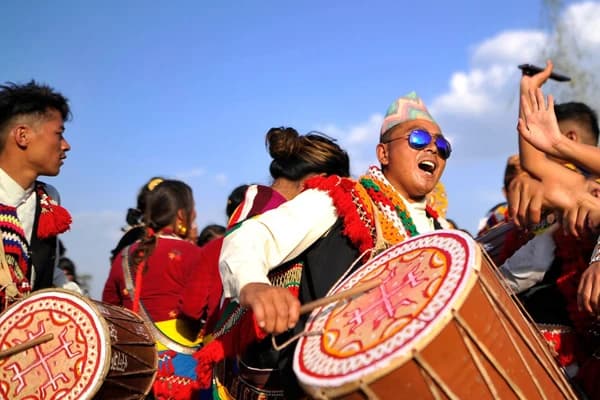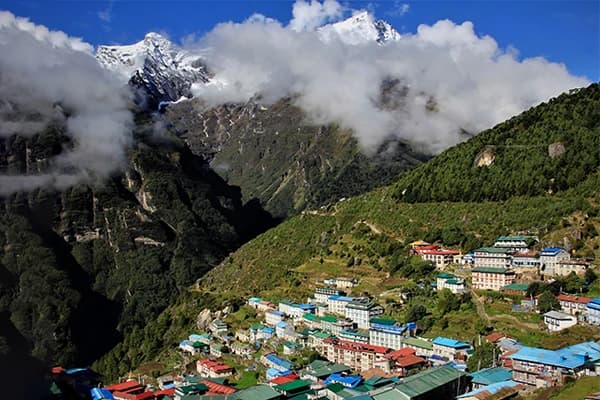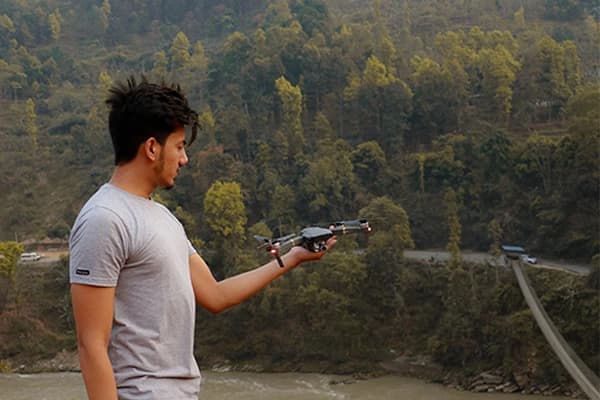How to access the Khumbu Glacier?
The Khumbu Glacier is accessible by trekking. From Kathmandu, you have to take the short flight to the lukla airport. It is a 40-minute short flight. From Lukla, you have to do a multi-day trek following the everest base camp trekking trail.
There is no direct route to the glacier itself. So, you must follow the marked trails indicated by ribbons, blue arrows, and stone cairns. Also, you need to acclimatize properly to prevent altitude-related issues and potential health issues.
During the journey, you will encounter the Khumbu Icefall, which is the challenging part of the glacier. The above way is most popular among trekkers who trekked to the Khumbu Valley.
Some Quick Facts about Everest's Icy Heartbeat
- It is the world's highest glacier, with elevation ranging from about 4,900 meters to 7,600 meters.
- The glacier is located in the Khumbu region of northeastern Nepal.
- Khumbu is situated within Sagarmatha National Park (a unesco world heritage site).
- The length of Khumbu is approximately 17 kilometers (10.5 miles) to 27 kilometers (17 miles).
- The glacier is famous for the Khumbu Icefall (section of ice near everest base camp).
- It is on the main route of the Everest base camp trek.
- The glacier is covered with moraines—rocks and debris carried along by the ice flow.
- It holds cultural and spiritual significance for the local Sherpa communities.
- Khumbu feeds the rivers and the lakes, like Imja Tse Lake.
Importance of the glacier
The Khumbu glacier is an important freshwater reservoir and an ecosystem driver in the Everest region. It feeds numerous rivers like Lobujya (Lobuche) River in the Everest region when it melts. These rivers are vital for the daily water needs of the local villages inhabited by the sherpa communities, agriculture, and livestock.
Besides it, the glacier sustains the high altitude ecosystem of Everest region. The ecosystems like wildlife and vegetation highly depend upon the water melted from it. Even in the harsh weather conditions the biodiversity sustains because of the glacier.
Physical Characteristics
Talking about the physical characteristics of the Khumbu Glacier, it is the highest glacier in the world, the largest in nepal, and one of the longest in the Everest region. It stretches roughly 17 to 27 kilometers in length and covers an area of about 70 square kilometers.
The glacier’s surface is made of a mixture of ice and extensive debris cover (rocks and moraines). The upper part of the debris consists of medium-grained metamorphic rock (schist).
One of the main parts of the glacier is the Khumbu Icefall, located at the west end of the lower Western CWM. It is chaotic and has a steep cascade of ice blocks and deep crevasses.
The surroundings of the glacier are also interesting. The glacier is bordered by the lateral and terminal moraines. The moraines were formed by the debris deposited during the movement.
In addition, the melted water of the glacier forms several small glacial lakes and streams. Those small lakes and streams later contribute to the Everest region’s hydrology.
The temperature variations on the glacier surface are influenced by the thickness of the debris cover. The downstream temperatures increase, especially when the debris is thicker.
Trekking to the Khumbu Glacier
The trek to the Khumbu Glacier follows a similar path as the Everest Base Camp trekking trail. The trek begins from Lukla (the gateway to the Khumbu Valley). The other popular trekking routes that will take you to the glacier are the everest gokyo lakes trek and the everest three passes trek.
All the routes have different difficulty levels, and the itinerary is also different. The everest base camp short trek can be completed in 12 days, the Gokyo lakes trek in 18 days, and the three passes trek in 20 days. The below itinerary is the shortest trekking itinerary to the Khumbu Glacier.
- Day 01: Arrival in Kathmandu and Transfer to Hotel
- Day 02: Fly to Lukla and trek to Monjo
- Day 03: Trek to namche bazaar
- Day 04: Acclimatization day in Namche Bazaar
- Day 05: Trek to Tengboche
- Day 06: Trek from Tengboche to Dingboche
- Day 07: Acclimatization day in dingboche
- Day 08: Trek to Lobuche
- Day 09: Trek to Gorak Shep, hike to Everest Base Camp, and come back to Gorak Shep.
- Day 10: Hike to Kala Patthar, come back to Gorakshep, and trek to Pangboche.
- Day 11: Trek to Namche Bazaar
- Day 12: Trek to Lukla
- Day 13: Fly From Lukla to Kathmandu
- Day 14: Final Departure, transfer to airport
The key challenges of the trek are altitude sickness, terrain, and trek itinerary. As it is a high-altitude trek, altitude-related issues may happen. Gradual ascent, hydration, and acclimatization days are the keys.
The terrain and itinerary challenges, like steep ascents, uneven terrain, and long hiking hours, can be managed by the proper preparations. Build physical endurance and a positive attitude. Furthermore, hire a professional guide to navigate the remote terrain challenges.
Best Time to visit Khumbu Glacier
The best times to visit the Khumbu Glacier are always the springs and autumns. These seasons offer stable weather conditions with unobstructed views.
The spring season comes before the monsoon season and offers the milder temperatures, longer daylight hours, and blooming rhododendrons. The early spring may have snow with chilly mornings and evenings.
The autumn season is almost similar to the spring season. The weather conditions are stable, skies are clear, and temperatures are milder. However, autumn has its uniqueness.
For example, autumn is a post-monsoon period that does not have flower blooms. And the days are also shorter than in the spring.
The other seasons, like the winter season, offer harsh weather conditions with freezing cold and heavy snowfall. While the monsoon season comes with frequent rainfall, clouds in the sky, slippery trails, and so on.
Environmental Concerns
Due to reasons like climate change and human activity, the glaciers of the Khumbu are melting. It threatens the local communities, ecosystems, and downstream water supplies along with the glacier itself.
As of now, the Khumbu glacier has lost approximately 50 meters in thickness over time. The rate of retreating for the past 20 years is about 30 meters per year. It is the general observed shrinkage and glacier melting.
New studies show that the glacier is thinning about 1 meter per year. The ice surfaces are lowering, and the glaciers are becoming flatter due to the melting and debris cover.
Also, the glacier velocity has slowed down, which means the ice flow has also reduced. This situation leads to the increased melting and ponding of the meltwater on the glacier surface.
These facts show that we need to be serious about environmental concerns. The environmental challenges are complex and interconnected. It requires coordinated research, monitoring, and conservation efforts to safeguard both glaciers and the communities dependent on them.
Practical Tips for Trekkers
- Choose the best times, like spring or autumn, for your trekking journey.
- Prepare well physically and mentally before going for the trek.
- Ensure you have all the necessary permits and passes.
- Ascend slowly and follow the recommended itinerary to reduce the risk of altitude sickness.
- Stay hydrated and maintain your energy levels by having protein- and energy-dense snacks.
- Be aware of the altitude sickness symptoms of yours and your friends.
- Wear quality boots and gear.
- Carry your personal medications and other essentials.
- Hire a professional guide or porter for better experiences.
- Check the weather forecast before heading to any destinations.
- Navigate the terrains safely and use trekking poles for balance.
- Be prepared for the limited amenities in the high altitudes of the Everest region.
- Respect the local customs and traditions while exploring the villages.
- Follow the leave no trace principle.
Conclusion
Khumbu Glacier, also known as Everest's Icy Heartbeat, is a remarkable natural wonder situated near Mount Everest. It is a colossal river of ice, stretching approximately 12 to 22 kilometers. From there you can witness the stunning natural beauty of the surroundings.
The surrounding terrains of the glacier are challenging, which makes it difficult, but still it is accessible by the treks, like the Everest base camp treks. On this trek, you will get to experience the rich culture and thrilling experiences when trekking to the Khumbu Glacier.
Want to go deeper than the trail? Explore Khumbu’s raw, icy wonder with our glacier-guided routes.





